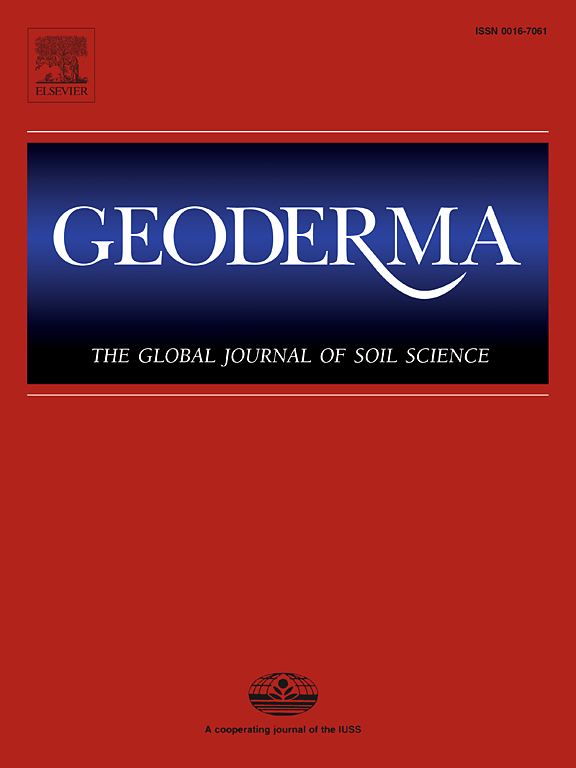基于Cd同位素示踪和清单分析的废弃矿区流域土壤重金属来源和输入输出路径定量研究
IF 5.6
1区 农林科学
Q1 SOIL SCIENCE
引用次数: 0
摘要
区域尺度土壤重金属源的定量分析面临重大挑战。广泛使用的源分配模型(正矩阵分解,PMF)的可靠性仍有待验证。此外,PMF仅基于土壤浓度动态评估源库变化及其对HM积累趋势的影响的能力有限。因此,将Cd同位素数据(使用MixSIAR贝叶斯模型和三端成员模型进行分析)、PMF模型和投入/产出清单相结合,共同量化废弃矿区流域土壤中HMs的通量和来源。土壤hm的年总输入通量(2160 g/ha/y)显著高于输出通量(486 g/ha/y),导致Cd、Cu和Zn的年净增长率分别为-0.495、359和43.6µg/kg/y。灌溉水(1776 g/ha/y)和浸出水(417 g/ha/y)是所有土壤基质的主要输入和输出途径。土壤Cr、Ni主要来源于自然,Cd、Cu、Zn主要来源于灌溉用水,Pb主要来源于大气沉降。上游水体、复合肥和表层土壤与镉的来源关系密切。三种模型的组合在Cd流入的定量和来源特定数据上显示出良好的一致性,表明受露天坑影响的灌溉水是主要的Cd来源(PMF、three- end - member和MixSIAR-Bayesian模型分别为79%、62%和77%)。这个全面的分析框架为量化HM来源和阐明其在复杂农业生态系统中受地质-人为双重影响的多相运输动力学提供了一个强大而广泛适用的策略。本文章由计算机程序翻译,如有差异,请以英文原文为准。
Quantification of sources and input-output pathways of heavy metals in soils from an abandoned mining watershed using Cd isotope tracing and inventory analysis
Quantitative analysis of regional-scale soil heavy metal (HM) sources presents significant challenges. The reliability of the widely used source apportionment model (positive matrix factorization, PMF) remains to be validated. Moreover, PMF are limited in their ability to dynamically assess source-sink changes and their impact on HM accumulation trends based solely on soil concentrations. Therefore, Cd isotopic data (analyzed using both the MixSIAR Bayesian model and a three-End-Member model), the PMF model, and input/output inventories were integrated to jointly quantify the fluxes and sources of HMs in the soils from an abandoned mining watershed. The total annual input flux of soil HMs (2160 g/ha/y) was significantly higher than the output flux (486 g/ha/y), resulting in net annual increase rates of Cd, Cu, and Zn of –0.495, 359, and 43.6 µg/kg/y, respectively. Irrigation water (1776 g/ha/y) and leaching water (417 g/ha/y) were the main input and output pathways for all HMs. Soil Cr and Ni originate from natural sources, Cd, Cu, and Zn mainly from irrigation water, and Pb from atmospheric deposition. A strong source relationship of Cd among upstream water, compound fertilizers, and surface soils was found. Combination of the three models showed good consistency in quantitative and source specific data for influx of Cd, indicating that irrigation water affected by open pits is the major Cd source (79 %, 62 % and 77 % for PMF, three-End-Member, and MixSIAR-Bayesian models, respectively). This comprehensive analytical framework provides a robust and broadly applicable strategy for quantifying HM sources and elucidating their multi-phase transport dynamics within complex agroecosystems subject to dual geogenic-anthropogenic influences.
求助全文
通过发布文献求助,成功后即可免费获取论文全文。
去求助
来源期刊

Geoderma
农林科学-土壤科学
CiteScore
11.80
自引率
6.60%
发文量
597
审稿时长
58 days
期刊介绍:
Geoderma - the global journal of soil science - welcomes authors, readers and soil research from all parts of the world, encourages worldwide soil studies, and embraces all aspects of soil science and its associated pedagogy. The journal particularly welcomes interdisciplinary work focusing on dynamic soil processes and functions across space and time.
 求助内容:
求助内容: 应助结果提醒方式:
应助结果提醒方式:


